高校党员管理系统的设计与实现(SQLServer)(含录像)(任务书,开题报告,中期检查表,外文翻译,毕业论文12400字,程序代码,SQLServer数据库,答辩PPT,答辩视频录像)
摘 要
随着计算机技术的飞速发展,党员也已进入信息化时代。为了使党员管理更高效、更科学,决定开发党员管理系统。
本文采用自顶向下的结构化的系统分析方法,阐述了一个功能全面的党员管理系统的开发过程、操作流程及其一些核心的技术。本文首先进行了项目概述,简单介绍了项目开发的背景、项目开发的目的和项目开发的意义;接下来是系统规划阶段,通过实际的业务流程调研,分析了系统的组织结构,具体完成了党员管理系统的需求分析、可行性分析、现行业务流程分析,并通过对现行业务流程的优化,得出了系统的业务流程;之后是系统分析,具体完成了数据流分析和数据字典;系统设计阶段主要完成了功能模块的划分、数据库的设计和系统界面设计。该阶段对各个模块的功能进行了详细设计,形成了本系统的功能模块图,在此基础上选择了合适的开发模式;数据库的设计先进行了概念结构设计,之后进行了逻辑结构设计,最后完成了数据库表的设计。
根据前几个阶段的分析和设计,本系统在设计方面采用C/S模式,同时使用JSP技术进行基本页面的设计与功能实现,后台数据库选用SQL Server 2000数据库。本文主要是介绍主编的功能,包括用户管理、专家管理、主编审批管理等。
关键词:党员管理;结构化分析;JSP
Design and implementation of college party management system
Abstract
With the rapid development of computer technology, Party member have entered the information age. To make Party member management more efficient, more scientific, decided to develop Party member management system.
In this paper, top-down structured systems analysis, describes a full-featured Party member management system development process, operational processes and some of its core technology. This paper carried out the project overview, a brief background of project development, project development and project development objective of the meaning; followed by the system planning stage, the actual business processes through research and analysis of the system's organizational structure, specifically the completion of the journal online submission system requirements analysis, feasibility analysis, the existing business process analysis, and optimization of existing business processes, business processes, the system obtained; followed by systematic analysis of the specific completion of the data flow analysis and data dictionary; system design primarily the completion of the division of function modules, database design and system interface design. This phase of the function of each module in detail the design, forming a functional block diagram of the system, on this basis, have chosen the right development model; database design first tested the concept design, followed by a logic design, and design of the database table.
According to the first few stages of the analysis and design, the system used in the design of C / S mode, JSP technology, the basic page design and implementation of function, use SQL Server 2000 database backend database. Design and implementation of this system for the Party member management system to run as a foundation for the Party member management system provides good conditions.
Keywords: Party member management; structural analysis; System; JSP
登录模块
此模块的主要功能是通过用户输入用户名和密码来判断该用户是否是本系统用户和判断用户权限的级别(普通用户或者主编或者专家)。系统会按照使用者提供的用户名和密码与数据库读出的数据来判断用户。若数据不匹配则会弹出输入错误提示框。
查看系统属性
管理员登录本系统后,可以查看系统属性信息。
修改密码
管理员登录本系统后,可以修改登录密码信息。
系统可以实现管理员的添加与删除。为了系统的安全性,需要为管理员设置账户与密码。该模块便为实现这一功能。
机构管理界面
管理员登录本系统后,可以管理机构信息。
在大学中,由于每一年都会有班级的变动,而以班级为单位的党支部也会随之改变,从而党员管理系统中的党支部也就需要更新,为了实现这一功能,添加机构管理模块,以实现党支部的增加和删除,以及党支部的信息更改。
党员管理查询
管理员登录本系统后,可以管理党员信息。
在高校党员管理系统中,最核心的功能就是管理党员信息,最基本的信息内容有姓名、性别、所在党支部、联系方式、所在系等等。尤其是高校党员管理系统对党员信息修改尤为频繁。随着每一届学生的变动,党员信息也随之改变。所以,高校党员管理系统需要实现党员信息的修改,增加,删除,查询等基本功能。在党员管理模块中,添加并实现这些功能。
党员录入界面
管理员登录本系统后,可以录入党员信息
前面提到党员管理系统中的几个核心功能,其中最重要的党员信息的录入。为了使整个系统操作更方便简介,特意将党员信息录入功能独立添加为一个模块,使整个系统功能更完整。
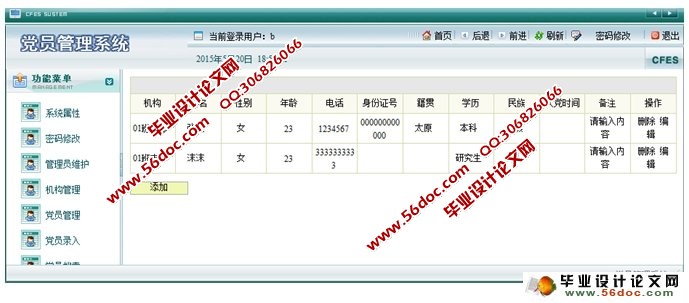
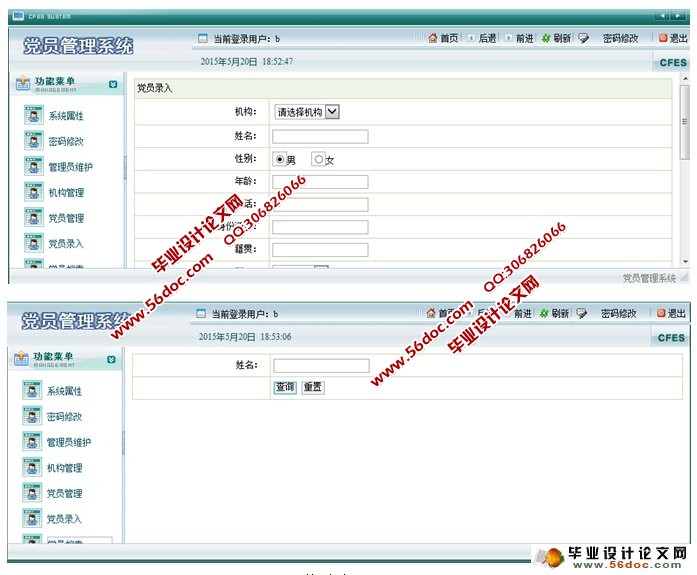
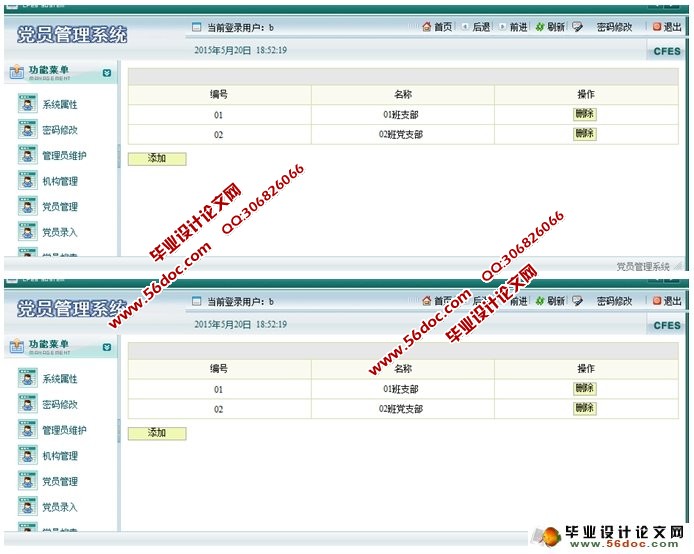
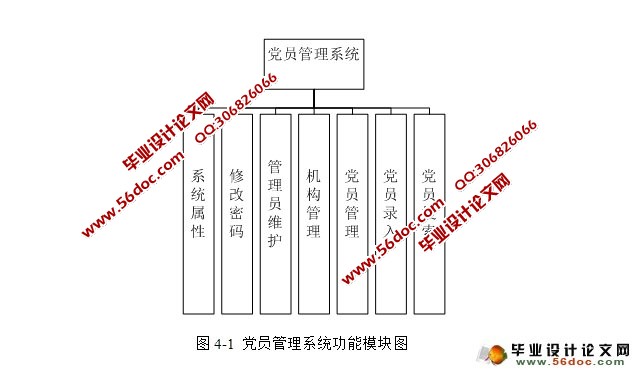
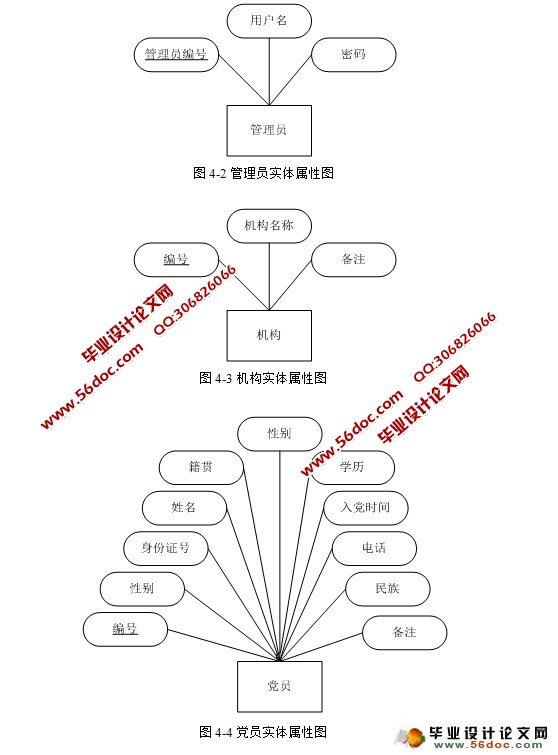
目 录
第1章 引言 1
1.1 项目开发的背景 1
1.2 项目开发的意义 2
第2章 关键技术介绍 3
2.1 JSP技术 3
2.2 SQL Server 2000技术 3
2.3 JAVA语言 5
2.4 系统开发模式 6
第3章 系统分析 7
3.1 系统可行性分析 7
3.1.1 技术可行性 7
3.1.2 经济可行性 7
3.1.3 社会可行性 8
3.2 业务流程分析 8
3.3 数据流图 9
3.4 数据字典 10
第4章 系统设计 13
4.1 系统功能设计 13
4.2 系统数据库设计 13
4.2.1 概念结构设计 13
4.2.2 数据库表设计 15
第5章 系统实现 17
5.1登录模块 17
5.1.1 登录界面 17
5.2 查看系统属性界面 18
5.3 修改密码界面 19
5.4 机构管理界面 20
5.5 党员管理查询界面 23
5.6 党员录入界面 27
第6章 系统测试与分析 29
6.1 系统测试的重要性 29
6.2 测试实例的研究与选择 29
6.3 测试环境与测试条件 30
6.4 系统运行情况 30
6.5 系统评价 30
第7章 总结 32
参 考 文 献 33
致谢 34
|











